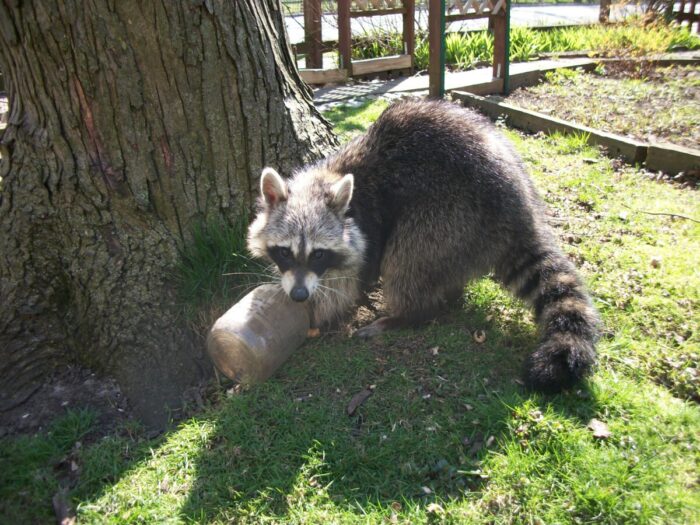
A raccoon recently showed up in my backyard in the early afternoon. It happens every spring. This is an indication the raccoon is a new mom and her world has turned temporarily upside down. Working with raccoons for many years has taught me a lot and it would behoove us to have a better understanding of what’s going on with them.
Depending on when she goes into labor and senses the time is near, it changes her regular routine to go out and forage that evening. She will need to come out and forage at different times when it’s best to leave her cubs alone. Fathers are not involved as parents.
Simply seeing a raccoon in the daytime may cause concern in people. Furthermore, raccoons shed their winter coats in the spring and when seen in daylight, they may look unkempt and unhealthy but it’s normal.
The shedding starts in the hindquarters and continues upward. The fur is clumpy, known as “cracking,” as it’s replaced by new lighter fur. It’s a gradual process, as they don’t have anyone brushing them to help the transition.
In and Out of the Den
Cubs can be born from March through June, so they’re sleeping a lot at first. They can become quite a pawful for the new mom. She gets woken up by the cubs and has to juggle her parenting responsibilities with her own survival. Her cubs may literally drive her out of the den at times. Sometimes a new mom would come by in the afternoon and nap in a nesting box in the yard.
Mother raccoons usually have more than one den. They search areas in their neighborhood including peoples’ homes. Keeping tree branches trimmed away from the house will prevent them from gaining access to roofs. If they find a weakness in a structure, they may try to break in and move into an attic.
Dens can be anywhere a raccoon can enter where she feels safe, including abandoned houses and garages, crawl spaces, under porches, etc. If one has moved in, homeowners can do a natural eviction, but it needs to be planned.
Raccoons will usually leave the den once dark and that’s the time to gather the cubs. They should be placed somewhere safe in a comfortable box as close to the den as possible, so she can find them. Of course, the opening of the property has to be secured right away to prevent her from moving back.
On one hand, it’s a compliment when wildlife moves into your space because you are tolerable to them. However, most people don’t see it that way. To help them move out, the place needs to be made annoying to them. Lights, loud music, noise, lots of activity, ammonia-soaked rags or moth balls near the area, will help them want to seek another place. Mesh netting bags that hold onions or other vegetables are ideal for moth balls and they can be tied to something.
If you’re creative, it’s not difficult to relocate them by making a nesting box. However, it’s best to secure it off the ground somewhere. Cats may move in if it’s on the ground.
Natural Rhythms
Animals have a circadian rhythm just like us. Another consideration is in spring, the daylight lasts longer until we reach the summer solstice. We may be more likely to see them in spring evenings, as opposed to winter when it’s dark much earlier.
Furthermore, it’s not unusual that our urban wildlife is not as distant from humans as those in rural areas. People have taken over their space and frankly, we owe them. We need to be educated on what is ‘normal’ considering natural life cycles. Working with nature and wildlife rather than against, has a better outcome for all of us.
The picture starts everything very well. It’s a perfect picture with the arched back and the masked face. It shows the paws exploring. Very good. And the picture is in daylight proving that the coons can show up in the early afternoon this time of the year when cubs are involved.
March thru June. This is important for us to know. Since they look for branches near homes and weaknesses in structures, we have to button up the house.
Natural evictions are a good idea. AC-DC would be good music probably opposed by most coonies. So much great information and awareness in this article to help keep the peace between the wildlife and the humans. It doesn’t take much effort to avoid a problem.
Thank you, I’m glad you appreciated it. Lots of people don’t care for them. That was funny about AC/DC music blasting them out. Issues with them can be an opportunity to learn about them and cohabitate successfully. Our property is ours to a certain extent.